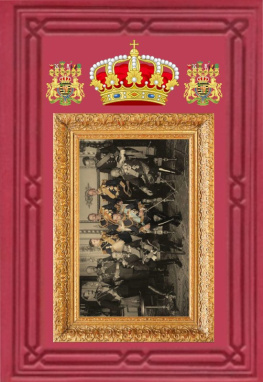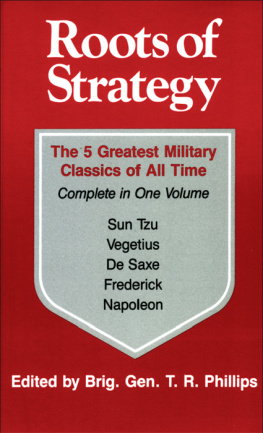Erfurth Waldemar Freytag-Loringhoven(Johann) - Roots of Strategy 3
Here you can read online Erfurth Waldemar Freytag-Loringhoven(Johann) - Roots of Strategy 3 full text of the book (entire story) in english for free. Download pdf and epub, get meaning, cover and reviews about this ebook. year: 1991, publisher: Stackpole Books (NBN), genre: History. Description of the work, (preface) as well as reviews are available. Best literature library LitArk.com created for fans of good reading and offers a wide selection of genres:
Romance novel
Science fiction
Adventure
Detective
Science
History
Home and family
Prose
Art
Politics
Computer
Non-fiction
Religion
Business
Children
Humor
Choose a favorite category and find really read worthwhile books. Enjoy immersion in the world of imagination, feel the emotions of the characters or learn something new for yourself, make an fascinating discovery.
- Book:Roots of Strategy 3
- Author:
- Publisher:Stackpole Books (NBN)
- Genre:
- Year:1991
- Rating:5 / 5
- Favourites:Add to favourites
- Your mark:
- 100
- 1
- 2
- 3
- 4
- 5
Roots of Strategy 3: summary, description and annotation
We offer to read an annotation, description, summary or preface (depends on what the author of the book "Roots of Strategy 3" wrote himself). If you haven't found the necessary information about the book — write in the comments, we will try to find it.
Roots of Strategy 3 — read online for free the complete book (whole text) full work
Below is the text of the book, divided by pages. System saving the place of the last page read, allows you to conveniently read the book "Roots of Strategy 3" online for free, without having to search again every time where you left off. Put a bookmark, and you can go to the page where you finished reading at any time.
Font size:
Interval:
Bookmark:

Roots of
Strategy
Book 3
3 Military Classics
von Leebs DEFENSE
von Freytag-Loringhovens
THE POWER OF PERSONALITY IN WAR
Erfurths SURPRISE
Stackpole Books
Copyright 1991 by Stackpole Books
Published by
STACKPOLE BOOKS
5067 Ritter Road
Mechanicsburg, PA 17055
www.stackpolebooks.com
All rights reserved, including the right to reproduce this book or portions thereof in any form or by any means, electronic or mechanical, including photocopying, recording, or by any information storage and retrieval system, without permission in writing from the publisher. All inquiries should be addressed to Stackpole Books, 5067 Ritter Road, Mechanicsburg, PA 17055.
Cover design by Caroline Miller
Printed in the United States of America
First Edition
10 9 8 7
Library of Congress Cataloging-in-Publication Data
(Revised for volumes 2 & 3)
Roots of strategy.
Includes index.
Contents: [Bk. 1]. The art of war / by Sun Tzu.
The military institutions of the Romans / by Vegetius.
My reveries on the art of war / by Maurice de Saxe.
The instruction of Frederick the Great for his
generals. The military maxims of Napoleon. - Bk. 2.
Battle studies / by Ardant du Picq. Principles of
war / by Carl von Clausewitz. Jominis Art of war.
Bk. 3. Von Leebs Defense. Von Freytag-Loringhovens
The power of personality in war. Erfurths Surprise.
1. Strategy. 2. Military art and science.
I. Phillips, Thomas Raphael, 1892
U161.R66 1985 355.02 84-26685
ISBN 0-8117-2194-9 (v. 1)
ISBN 978-0-8117-2194-3 (v. 1)
von Freytag-Loringhovens
The Power of Personality in War
Field Marshall General Ritter von Leeb
First translation, 1943,
by
Dr. Stefan T. Possony
and
Daniel Vilfroy
Part I
Defense in the First World War
Part II
Defensive Conceptions, German School, Between Wars
Part III
Strategic and Tactical Defense, World War II
Maps
T HE principles of conduct of war and conduct of combat as expounded in this book by Field Marshal General Ritter Wilhelm von Leeb were written only a few years before the present war.
Von Leeb realistically and meticulously examined and reexamined the existing conceptions of defense to analyze what of value remained from World War I. He originally published his theories in the Militaerwissenschaftliche Rundschau (The Scientific Military Review) of the German War Office. They were later issued in book form, under the title Die Abwehr, in Berlin in 1938, and appear for the first time in English translation in this work.
In his DEFENSE von Leeb, as a military thinker and scientist, comparable to any of the outstanding authorities of the old German armySchlieffen, Falkenhayn, Groner, Seeckt, etc.offered his government a plan for the next war in which Germany might be engaged. It is estimated by competent judges as probably the most important piece of research in the field of strategy and tactics in modern warfare that has appeared in a decade.
The substance of von Leebs theories was developed in parallel and simultaneously in Berlin and Moscow. Some of the ideas were included in the 1936 Soviet Field Service Regulations. However, according to Max Werner, Hitler rejected von Leebs plan, while the Russian army in 1941 fought under it and stopped the Germans.
Von Leebs recommendation was that the war be opened with active defense, as a preparation for the offensive later. He wrote in DEFENSE:
Since in any war to come we [Germany] cannot count on numerical superiority or superiority in war materials, the defense must help to support and prepare the attack, which can alone bring a decision. In event of the enemys absolute superiority, his strength and power must be worn down.
His plan of defense was to be adjusted in accordance with the enemys war plan, with the object of maintaining a successful defense against it, for, as he wrote:
We know that defense is dependent upon attack. It must be adapted to the measures of the aggressor. Its state is that of operative and tactical dependence upon the attacker in war, in an operation or in an engagement.
Defense is aimed at attaining a shift in favor of the defender in the balance of power.
More than ever before, the defense is in a position to serve its original purpose, on account of its increased power. The purpose is to break the strength of the attacker, to parry his blows, to weaken him and to bleed him white. The reversal of strength resulting from this will enable the defender himself to acquire the strength to attack.
In emphasizing the importance of having at all times ample reserves in readiness, von Leeb says:
In the final analysis the question of which side can maintain fresh reserves decides the success of the defense as well as that of the break-through.
Use of weapons of offense is required in the defense.
The defense, as well as the attack, can put aviation and speedily-moving units of all sorts to excellent use. They certainly can mitigate, even neutralize, perhaps, the advantages possessed by the offensive in tanks and planes. Weapons of the same kind must be opposed by Operative defense to an attack by such arms and weapons. These are needed by the defense as well as the attack
Strategy of attrition against a stronger enemy is urged by him.
The first aim, when the enemy has great superiority, is to reduce the disproportion by strategy of delaying combat; a strategy of attrition that has for its purpose the weakening of the enemy to a point where one is strong enough to attack.
Two combat forms are placed by von Leeb to the forefront of effective modern defensive strategy, i.e.: battle in depth and systematic cooperation between different service arms.
Mobility in grouping, deep rear organization, are demanded by tactical defense. Also formations in deep echelon. By these one is enabled to absorb enemy surprise actions, to slow up the attack and entangle the enemy in an advanced defense network, to deprive him of his strength and, above all, to gain time for countermeasures. New weapons and means of combat, fast units, aviation, the broad use of all kinds of artificial obstacles are today in a position to make the defense more varied, more mobile, to take it away from rigid linear forms of trench warfare and to organize it in depth.
Coordination of all arms and means is a basic condition for full utilization of every defense possibility. In our war experience, 1914-18, we learned the meaning of close cooperation amongst all infantry arms and between artillery and infantry. But before an enemy equipped with strong armored forces, this cooperation is no longer sufficient. It now must be augmented by a uniform plan of antitank defense; employment of all means of reconnaissance, use of artificial obstacles of all kinds, combined use of all offensive arms, the preparation and use of reserves, armored units, aviation. Not one arm alone nor one method by itself brings the decision. Cooperation amongst all of them is necessary.
Von Leeb, known as the Family-Tree General because of his authorship of the Chronicle of the von Leeb Family, is an aristocrat famed for his austerity and forbidding personality.
If von Leeb ever tried to smile, it would crack his face, his friend, Marshal Siegmund Wilhelm List, said of him.
Font size:
Interval:
Bookmark:
Similar books «Roots of Strategy 3»
Look at similar books to Roots of Strategy 3. We have selected literature similar in name and meaning in the hope of providing readers with more options to find new, interesting, not yet read works.
Discussion, reviews of the book Roots of Strategy 3 and just readers' own opinions. Leave your comments, write what you think about the work, its meaning or the main characters. Specify what exactly you liked and what you didn't like, and why you think so.








